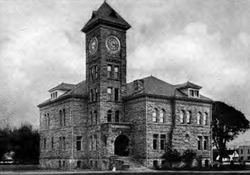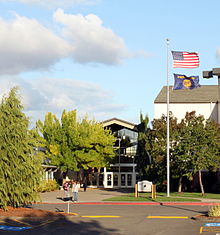- Dallas, Oregon
-
Dallas, Oregon — City — Polk County Courthouse Motto: Commitment to Community - People Serving People Location in Oregon Coordinates: 44°55′16″N 123°18′59″W / 44.92111°N 123.31639°WCoordinates: 44°55′16″N 123°18′59″W / 44.92111°N 123.31639°W Country United States State Oregon County Polk Incorporated 1874 Government - Mayor Brian Dalton Area - Total 4.4 sq mi (11.5 km2) - Land 4.4 sq mi (11.5 km2) - Water 0 sq mi (0 km2) Elevation 325 ft (99.1 m) Population (2010[1]) - Total 14,583 - Density 3,031.8/sq mi (1,170.4/km2) Time zone Pacific (UTC-8) - Summer (DST) Pacific (UTC-7) ZIP code 97338 Area code(s) 503 and 971 FIPS code 41-17700[2] GNIS feature ID 1162930[3] Website www.ci.dallas.or.us The city of Dallas is the county seat of Polk County, Oregon, United States. The population was 14,583 at the 2010 census.[4]
Dallas is located on Rickreall Creek, approximately 15 miles west of Salem, at an altitude of 325 feet above sea level. It is part of the Salem Metropolitan Statistical Area.
Contents
History
Dallas was settled in the 1840s on the north side of Rickreall Creek and was originally named "Cynthian" or "Cynthiana".[5] A 1947 Itemizer-Observer article (quoted in 100 Years in Polk County: A Centennial Background) states: "[T]he town was called Cynthiana after Cynthiana, Ky., so named by Mrs. Thos. Lovelady." The History of Polk County Oregon, 1987, Page 12, states: "To Mrs. Thomas J. Lovelady was given the honor of naming the new settlement and she selected the name after her home town of Cynthiana, Kentucky."
Another source claims that the origin of the name may come from the name of Jesse Applegate's wife, Cynthia Ann.[5] However, she lived in the Salt Creek area of northern Polk County and, according to the 1850 Federal Census, had already left Polk County by 1850.
Dallas post office was established in 1852.[5] In 1856 the town was moved more than a mile south because of an inadequate supply of water.[5]
Dallas was in competition with Independence to be the county seat and the citizens of Dallas raised $17,000 in order to have a branch of the narrow gauge railroad come to their town, thus securing the honor.[5] The line was built from 1878–80.[5] A more suitable name for a county seat was needed, and since George Mifflin Dallas was vice-president under James K. Polk, for whom the county was named, "Dallas" was a natural choice.[5]
Dallas was incorporated as a town in 1874, and as a city in 1901.[citation needed]
Gerlinger family
Louis Gerlinger, Sr., incorporated the Salem, Falls City and Western Railway Company late in October 1901 and announced plans to build a railroad from the Willamette River at Salem to the mouth of the Siletz River on the Oregon Coast, a distance of 65 miles.[6]
In 1902, Louis's son George T. Gerlinger organized a group of investors to build railroad lines in the area.
On May 29, 1903, the first train ran from Dallas to Falls City. At the end of June, passenger trains began regularly scheduled trips to and from Dallas and Falls City each day; the nine-mile, forty-minute, one-way trip cost 35 cents.
Willamette Industries was founded in Dallas in 1906. At that time the company name was Willamette Valley Lumber Company.[7] Louis Gerlinger, Sr. was president of the new company and H.L. Pittock, vice president. George T. Gerlinger served as secretary and manager while F.W. Leadbetter was treasurer. George Cone served as director and mill superintendent.[6] In 1967 Willamette Valley Lumber and several others merged to become Willamette Industries.[8]
In March 2002, Willamette Industries was officially acquired by Weyerhaeuser Company in a hostile takeover. In early 2009, Weyerhaeuser's Mill formally closed down its Dallas operation.
Geography
According to the United States Census Bureau, the city has a total area of 4.81 square miles (12.5 km2), all of it land.[9]
Demographics
As of the census[2] of 2010, there were 14,583 people. The population density was 3,031.8 people per square mile (1,170.4/km²). There were 6,137 housing units at an average density of 1,275.9 per square mile (492.5/km²). The racial makeup of the city was 97.31% White, 0.23% African American, 2.03% Native American, 0.76% Asian, 0.13% Pacific Islander, 1.61% from other races, and 2.68% from two or more races. Hispanic or Latino of any race were 5.95% of the population.[10]
In 2000, there were 4,672 households out of which 35.8% had children under the age of 18 living with them, 55.0% were married couples living together, 12.1% had a female householder with no husband present, and 28.8% were non-families. 24.3% of all households were made up of individuals and 12.3% had someone living alone who was 65 years of age or older. The average household size was 2.57 and the average family size was 3.02.
In 2000, the population was spread out with 27.9% under the age of 18, 7.9% from 18 to 24, 25.9% from 25 to 44, 20.8% from 45 to 64, and 17.5% who were 65 years of age or older. The median age was 36 years. For every 100 females there were 92.4 males. For every 100 females age 18 and over, there were 85.2 males.
The median income in 2000 for a household in the city was $35,967, and the median income for a family was $45,156. Males had a median income of $34,271 versus $22,941 for females. The per capita income for the city was $16,734. About 7.8% of families and 9.8% of the population were below the poverty line, including 13.2% of those under age 18 and 5.8% of those age 65 or over.
Media
The Polk County Itemizer-Observer is a weekly newspaper published in Dallas since 1875.
Notable people
- Jeri Ellsworth - self-taught computer chip designer
- Carl Gerlinger - founder of Gerlinger Carrier Company
- George T. Gerlinger - founder of Willamette Industries, a Fortune 500 company before being bought out in 2002
- Louis Gerlinger, Sr. - founder of the Salem, Falls City and Western Railway
- Mark Hatfield - former Governor of Oregon and a United States senator from 1967–1997
- Johnny Kitzmiller - professional football and College Football Hall of Fame
- Johnnie Ray - popular 1950s singer and recording artist
- Jake Striker - 1950s and 1960s baseball pitcher
See also
References
- ^ "American FactFinder". US Census. http://factfinder2.census.gov/. Retrieved April 25, 2011.
- ^ a b "American FactFinder". United States Census Bureau. http://factfinder.census.gov. Retrieved 2008-01-31.
- ^ "US Board on Geographic Names". United States Geological Survey. 2007-10-25. http://geonames.usgs.gov. Retrieved 2008-01-31.
- ^ "American FactFinder". US Census. http://factfinder2.census.gov/. Retrieved April 25, 2011.
- ^ a b c d e f g McArthur, Lewis A.; McArthur, Lewis L. (2003) [First published 1928]. Oregon Geographic Names (7th ed.). Portland, Oregon: Oregon Historical Society Press. p. 266. ISBN 9780875952772. OCLC 53075956.
- ^ a b Catherine A. Baldwin (1982). Making the Most of the Best: Willamette Industries' Seventy-Five Years. (Portland, OR: Willamette Industries, 172 p.).
- ^ Weyerhaeuser tries to take over Willamette Forest Industries
- ^ SEC 10K for 1999
- ^ "US Gazetteer files: 2010, 2000, and 1990". United States Census Bureau. 2011-02-12. http://www.census.gov/geo/www/gazetteer/gazette.html. Retrieved 2011-04-23.
- ^ "American FactFinder". US Census. http://factfinder2.census.gov/. Retrieved April 25, 2011.
External links
 Media related to Dallas, Oregon at Wikimedia Commons
Media related to Dallas, Oregon at Wikimedia CommonsMunicipalities and communities of Polk County, Oregon Cities Dallas | Falls City | Independence | Monmouth | Salem‡ | Willamina‡
CDPs Eola | Grand Ronde | Rickreall
Unincorporated
communitiesAirlie | Ballston | Bethel | Bridgeport | Brunks Corner | Buena Vista | Lewisville | McCoy | Modeville | Pedee | Perrydale | Salt Creek | Valley Junction | Zena
Indian reservation Ghost towns Footnotes ‡This populated place also has portions in an adjacent county or counties
Categories:- Dallas, Oregon
- Cities in Oregon
- County seats in Oregon
- Populated places in Polk County, Oregon
- Salem, Oregon metropolitan area
- Willamette Valley
Wikimedia Foundation. 2010.




